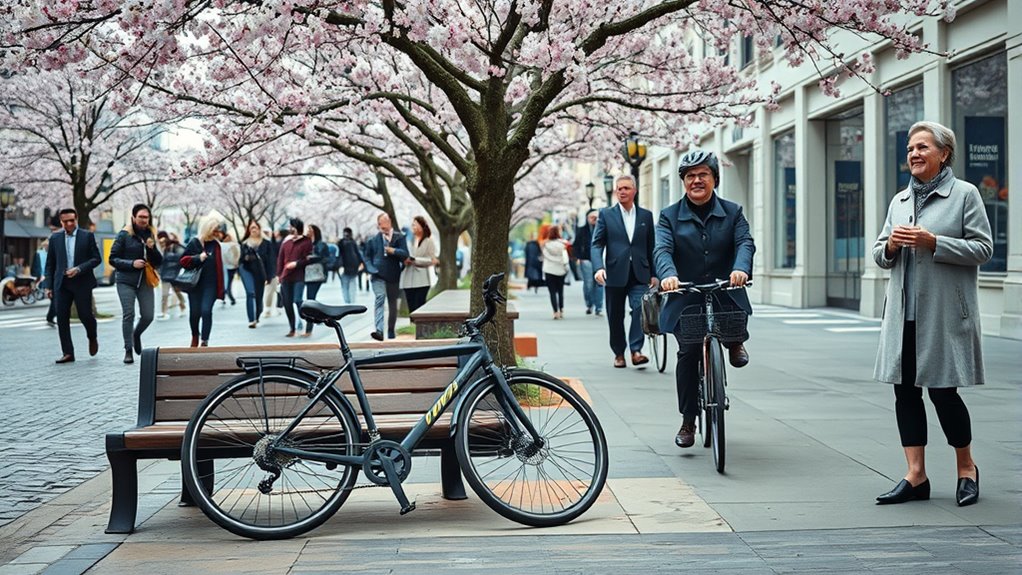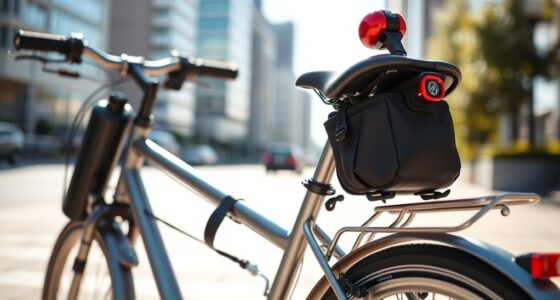When riding a folding bike in the city, you should always follow local transit policies and be respectful of other passengers. Fold your bike when required, avoid blocking aisles or exits, and use designated storage areas or bike racks. Don’t lock your bike to street signs or railings, and park in approved zones to prevent hazards. Showing consideration helps create a safer, more enjoyable environment for everyone—keep these tips in mind to ride courteously and responsibly. Continue on to learn more.
Key Takeaways
- Fold bikes before entering crowded transit areas or when staff advise to prevent obstructions.
- Use designated bike storage zones and avoid blocking pathways or exits.
- Respect transit rules regarding bike capacity and restrictions during peak hours.
- Lock bikes securely in approved parking areas to prevent theft and clutter.
- Demonstrate consideration by waiting for space and handling bikes carefully around others.

Folding bikes have become a popular way to navigate city streets efficiently, but riding them responsibly requires understanding proper etiquette. One of the most important aspects is respecting public transit policies. Many transit systems have specific rules about bringing bikes onboard, especially during peak hours. Some buses and trains limit the number of folding bikes allowed, or restrict them to certain carriages or times. Before you plan your trip, check the transit authority’s guidelines to avoid surprises or disruptions. Being aware of these policies helps guarantee you won’t obstruct aisles, block exits, or inconvenience other passengers. Always fold your bike before entering crowded areas or when instructed by transit staff, and be considerate by waiting for your turn to board if space is limited. Keeping your folding bike out of the way demonstrates respect for fellow commuters and maintains a smooth flow of transit operations. Additionally, choosing suitable bike storage areas can prevent accidental damage and ensure your bike remains in good condition for future use.
Another key element of city bicycle etiquette involves bike parking regulations. Many cities have designated bike racks and specific rules about where you can leave your folding bike. Even though your bike folds, it’s essential to park it in permitted areas to avoid fines or causing obstruction. Avoid locking your bike to street signs, railings, or blocking sidewalks, as these actions can create hazards for pedestrians and violate local ordinances. When parking, look for designated bike racks or areas marked for bike storage, and always secure your bike properly. Using a sturdy lock not only protects your bike from theft but also shows respect for the community’s shared space. Additionally, be mindful of space when parking your folding bike; don’t block entrances, crosswalks, or access points. Keeping your bike tidy and within the designated zones helps foster a harmonious environment and reduces the risk of conflicts with pedestrians or other cyclists.
Frequently Asked Questions
Are Folding Bikes Allowed on All Public Transportation Systems?
Most public transportation systems do allow folding bikes, but transit policies vary. You should check bike storage options and any restrictions beforehand. Many cities permit folding bikes during off-peak hours or in designated areas, making your commute smoother. Always follow specific transit rules, like folding your bike quickly and storing it properly, to avoid inconvenience or penalties. Being aware of these policies helps you enjoy hassle-free travel with your folding bike.
Can Folding Bikes Be Parked in Regular Bike Racks?
Yes, you can park your folding bike in regular bike racks, but you should verify for bike rack compatibility and local urban parking regulations first. Some racks might be too small or have restrictions, so make certain your folded bike fits comfortably without obstructing others. Following these guidelines helps you avoid fines and keeps the city organized, making city riding smoother and more enjoyable for everyone.
What Are the Best Practices for Signaling When Riding Folding Bikes?
When riding your folding bike, use clear hand signals to indicate turns or stops to other road users. Extend your arm straight out for a left turn, bend it upward for a right turn, and extend it downward to signal a stop. Don’t forget to use your horn sparingly to alert pedestrians or vehicles of your presence, especially in crowded areas. Combining hand signals with occasional horn usage guarantees safe and courteous riding.
How Do I Discreetly Carry My Folding Bike Indoors?
A word to the wise: “A stitch in time saves nine.” To discreetly carry your folding bike indoors, keep it folded and compact. Use a padded bag or cover for added noise reduction, ensuring it doesn’t disrupt others. Store it in a closet or under a table for indoor storage, keeping it out of sight. This way, you respect shared spaces and maintain peace while managing your bike efficiently.
Are There Specific Dress Codes When Riding Folding Bikes in Urban Areas?
You don’t need a strict dress code when riding folding bikes in urban areas, but it’s best to wear appropriate attire that suits your commute. Opt for comfortable, practical clothing that allows easy movement and keeps you dry and visible. Incorporate urban fashion elements like stylish jackets or sneakers to look good while staying functional. Being prepared with suitable attire guarantees you ride safely and blend seamlessly into city life.
Conclusion
So, next time you fold your bike in the city, remember: you’re not just saving space—you’re also saving face. Because nothing says “respect” like neatly tucked handlebars and a discreet wheel. Ironically, the more considerate you are, the more you blend in—until someone notices your perfectly folded bike and thinks, “Wow, what a city dweller.” So go ahead, fold away, and enjoy the silent applause of city etiquette. After all, it’s all about making city life smoother—one fold at a time.














